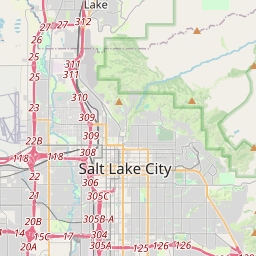Statue of Massassoit
Historical marker location:
320 East Capitol Boulevard, Salt Lake City, Utah
( Marker can be reached from East Capitol Boulevard north of 300 North, on the left when traveling north.)
Marker installed: 1959






© OpenStreetMap contributors
Loading...
Searching for other points of interest within 3 miles of this location.The first permanent non-indigenous settlement in Utah was established by Mormon pioneers in 1847. They founded the city of Salt Lake City and the state of Utah was later admitted to the Union in 1896.
About Salt Lake County
Salt Lake County Timeline
Salt Lake County, located in the state of Utah, has a rich history dating back thousands of years. The area was originally inhabited by various Native American tribes such as the Ute, Shoshone, and Paiute. These tribes thrived in the region due to the abundance of natural resources, including the Great Salt Lake and fertile lands provided by the Jordan River.
In the mid-19th century, Salt Lake County experienced a significant transformation with the arrival of Mormon pioneers led by Brigham Young. Seeking religious freedom, the Mormons established Salt Lake City as their permanent settlement in 1847. Under Young's leadership, the city became the center of the Church of Jesus Christ of Latter-day Saints (LDS Church) and the capital of the Utah Territory.
As the population of Salt Lake County grew, economic development expanded. The pioneers constructed irrigation systems to cultivate the arid land, enabling farming and the establishment of small towns throughout the county. The area's natural resources, such as timber, mining, and later on, petroleum extraction, also contributed to its economic growth.
Salt Lake County played a significant role in the national stage during the early 20th century. It was the center of the Progressive Movement and witnessed social and political reforms. The county also hosted important events, such as the 2002 Winter Olympics, which brought international attention to the region. Today, Salt Lake County remains a vital cultural, educational, and economic hub in Utah, preserving its history while embracing modern progress.
In the mid-19th century, Salt Lake County experienced a significant transformation with the arrival of Mormon pioneers led by Brigham Young. Seeking religious freedom, the Mormons established Salt Lake City as their permanent settlement in 1847. Under Young's leadership, the city became the center of the Church of Jesus Christ of Latter-day Saints (LDS Church) and the capital of the Utah Territory.
As the population of Salt Lake County grew, economic development expanded. The pioneers constructed irrigation systems to cultivate the arid land, enabling farming and the establishment of small towns throughout the county. The area's natural resources, such as timber, mining, and later on, petroleum extraction, also contributed to its economic growth.
Salt Lake County played a significant role in the national stage during the early 20th century. It was the center of the Progressive Movement and witnessed social and political reforms. The county also hosted important events, such as the 2002 Winter Olympics, which brought international attention to the region. Today, Salt Lake County remains a vital cultural, educational, and economic hub in Utah, preserving its history while embracing modern progress.
Salt Lake County Timeline
This timeline provides a glimpse into the major events and milestones that have shaped the history of Salt Lake County, Utah.
- 1847: Salt Lake County is founded by Mormon pioneers led by Brigham Young
- 1850: Salt Lake City becomes the capital of the Utah Territory
- 1869: The First Transcontinental Railroad is completed, bringing economic growth to the county
- 1870: Salt Lake County's population reaches over 20,000
- 1892: The Salt Lake Temple of The Church of Jesus Christ of Latter-day Saints is completed
- 1902: The Great Salt Lake is designated as a wildlife refuge
- 1920: Salt Lake County's population exceeds 200,000
- 2002: Salt Lake City hosts the Winter Olympics, bringing international attention to the county